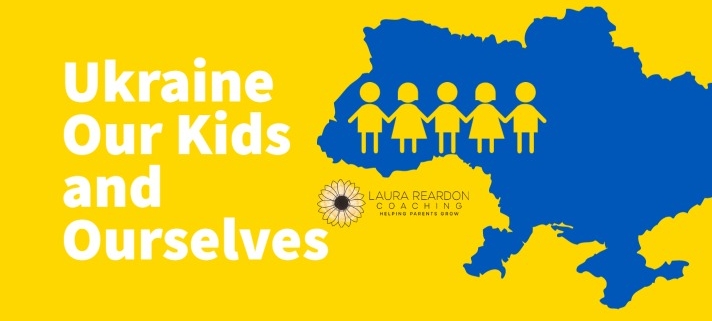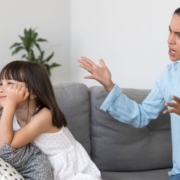Ukraine, Our Kids, and Ourselves
I’m that person who turns the tv off as quickly as possible when the reporter announces “What you’re about to see may be disturbing” …almost comically pressing the buttons on the remote control before the image appears.
And yet, as the war in Ukraine unfolds, I want to know what’s happening and so I wait a moment and then turn the news back on as I brace myself for what I’ll learn.
One morning this week I was brought to tears by the story of an aunt who was trying unsuccessfully to bring her niece and nephew from Ukraine to her home in California. Both of the siblings appeared to be teens. The older brother seemed calm on the outside, but I imagined the deep emotions underneath the surface. And the sister, almost completely covered by her hoodie, was trying to hide her teary face from the cameras.
These 2 siblings reminded me so much of my own son and daughter that my heart completely broke.
I recognized the feeling of anxiety begin to rise in my chest and throat…a familiar feeling but one that I haven’t experienced in some time.
And I wondered and I worried…will the aunt know how important it will be to encourage those kids to tell their stories.
When we tell our stories by using the logical side of our brain to remember the facts, the emotions side of our brain to revisit our feelings, and then identify healthy coping skills to support our ability to tolerate the facts and the feelings without lashing out or withdrawing…we can process difficult experiences in a healthy way that strengthens us rather than makes us more fragile.
I wish I could share the importance of telling our stories with their aunt…but I can share it with you because, even though we are not experiencing the trauma of war, we are experiencing a front row seat to the unfolding of the trauma of war…and that can affect our emotional well-being.
We can encourage our own kids to tell their stories to help them process what they are experiencing in a healthy way.
Facts: we can ask them what they’re hearing about Ukraine and Russia on their screens and from their friends. As needed, we can replace inaccurate information with accurate information. For older kids who have their own phone, we can use it as an opportunity to discuss the topic of reliable sources and how inaccurate information and sensational photos and videos can often be found on social media. We can ask if they have any questions. If they do, we can provide them with an age-appropriate answer while being cognizant not to provide more information than they’ve asked for as they may not be ready for more. And if we don’t know the answer that’s ok…we can learn together. If your kid doesn’t have any questions, that’s ok too. We can keep an open dialogue going with them in the weeks and months ahead.
Feelings: we can encourage them to put how they’re feeling into words because the more they can do this, the less likely their feelings will show themselves as physical symptoms or as challenging behavior. We can encourage them with our words and we can also encourage them with our actions by creating a sanctuary of emotional safety and strength in our home. We do this by acknowledging feelings with an attitude of acceptance that communicates the message “It makes sense you feel that way, I can handle your feelings, and I trust you can handle your feelings.” Whereas we discourage them from putting their feelings into words when we create an environment of emotional insecurity and fragility by responding to their feelings with an attitude of avoidance that communicates the message “I can’t handle your feelings and I don’t think you can either.”
Healthy Coping Skills: we can support our kids in processing what they are experiencing in a healthy way by creating an environment focused on healthy coping skills.
- Create Normalcy: we don’t need to hide what’s happening in the world from our kids, but neither do we need to expose them to stories or images of war. Instead, we can uphold familiar routines to create a sense of normalcy that things are the same at home, even while the outside world is changing.
- Spend more time together: no matter their age it’s important to spend time 1:1 and as a family doing things that create connection. Identifying a way the family can help provides kids the opportunity to focus on something positive they can do but connection through everyday moments like talking, playing games and having fun, walking, reading, or sharing a meal are also important.
- Movement and Relaxation: we can encourage our kids to move and to relax because research tells us that when we change our physical state through movement or relaxation, we change our emotional state.
- Change Our Thoughts: If our kids have worry thoughts we can respond with an attitude of acceptance and we can also encourage them to identify new thoughts such as “The whole world is working together to help.” When we change our thoughts, we can change our feelings and our actions.
- Present Moment Gratitude: we can encourage them to identify what is happening that is good.
And then we can make sure that we have someone in our life to tell our stories to and that we are identifying our own healthy coping skills…because our own emotional health is crucial for us to be able to help our kids with theirs.
With that in mind, later that morning after being brought to tears by the story and images of the two teens that reminded me of my own, I crossed over the yard to visit my mom who lives in a small house she built on our property…and we shared our stories.
Wishing you peace and connection through storytelling.
PS – If you’re looking for 1:1 support, schedule a free call here.










Thank you
Thank you for your response, Steve. This felt like a small way I could contribute…I hope it is helpful.